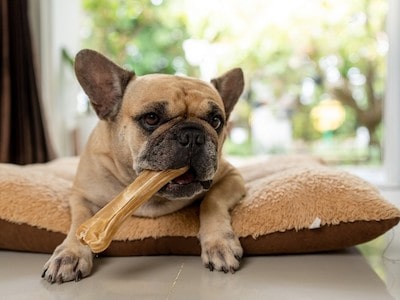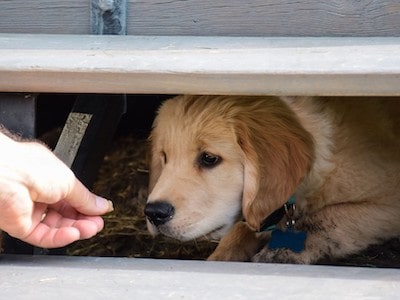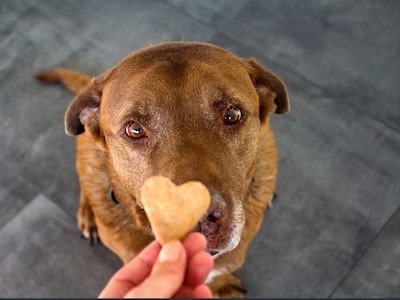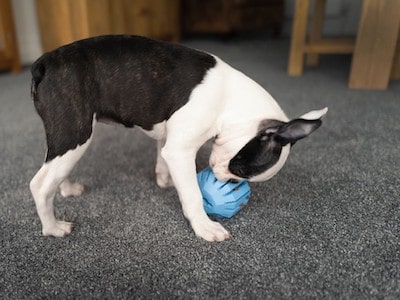Have you ever seen your pup surreptitiously burying treats in the backyard or concealing them underneath the couch cushions? It’s a typical behavior for dogs, and it can be rather entertaining to observe. But have you pondered why your canine companion is doing this? Is it merely an idiosyncrasy of theirs, or is there something more profound behind it?

Understanding your pup’s behavior is essential for providing them with the best care and companionship as a dog owner. That’s why we’re here to discover why dogs hide their treats. This blog article will explain the interesting reasons behind this habit, plus some tips on how to help your furry friend overcome it.
So, grab a cup of coffee, settle in and get ready for an enlightening read. When you finish this article, you’ll have increased your knowledge about your dog’s behavior and how to give them the love and care they deserve.
Table of Contents
Reasons Why Dogs Hide Their Treats
Dogs instinctively hide treats as a means of saving them for later, not wanting to pass them up even if they are already full. Furthermore, anxious dogs may also hide their treats so that they can consume them away from people and other dogs. Here, we have listed 6 top reasons why dogs hide treats:
- Instinctual Behavior: Instinctive hiding of food by dogs comes from their wild predecessors, who had to hunt for and conceal it to prevent theft by other animals. Though modern-day canines no longer have the need to search for their meals, the instinct to secrete it away still persists.

- Hoarding Behavior:Hoarding is a natural behavior in dogs, often seen when they hide their treats, and is associated with the need to have a secure food supply. This behavior may be more common in dogs that experienced food scarcity or were not fed consistently during their early lives.
- Anxiety or Fear: If your dog is exhibiting signs of anxiety or fear, they may hide their treats as a result of feeling insecure about food. Hiding their treats can be an indication that your pup is struggling with anxiousness or apprehension.

- Protecting Their Food: Dogs may hide their treats to protect them from other dogs or animals, particularly if they are territorial and fear that their treats will be taken away. Therefore, they put them in a safe place.

- Boredom: If dogs are bored or have too much energy, they might hide their treats to amuse themselves. This activity serves as both a mental and physical exercise for them, while also giving them a feeling of satisfaction.
- Habit: Dogs sometimes hide their treats out of habit, having formed a routine behavior that continues even if the original reason for doing so is no longer present.
How to Help Your Dog Overcome Hiding Their Treats?
If you notice your dog hiding their treats, there are a few things you can do to help them overcome this behavior:
- Provide Enough Food: Make sure your dog is getting enough food at mealtimes. If they are stashing away treats because they feel anxious about their food, providing them with a regular and sufficient amount of sustenance can help to reduce this behavior.

- Create a Safe and Comfortable Environment: Ensure that your dog feels safe and secure in their surroundings. Give them a cozy area to sleep, toys to enjoy and lots of love and care. A safe and pleasant atmosphere can help diminish any apprehension or disquiet which may be the cause of your dog hiding its treats.
- Avoid Punishing Your Dog: Rather than punishing your dog for concealing their treats, try to comprehend the rationale behind why they’re doing it and resolve the root cause.
- Encourage Positive Behaviors: Reward your dog with treats when they eat in front of you to encourage positive behaviors, as this type of positive reinforcement can help foster healthy habits.

- Offer Interactive Toys: Provide your dog with interactive toys that require them to work for their treats. These toys can provide mental stimulation and physical activity, which can help to reduce boredom and the need to hide treats.

FAQs
Is it normal for dogs to hide their treats?
Yes, it is normal for dogs to hide their treats. This behavior is instinctual and stems from their wild ancestors.
Should I be concerned if my dog hides his treats?
It depends on the reason why your dog is hiding his treats. If it’s due to anxiety or fear, it may be a sign of an underlying issue. However, if it’s simply a habit or instinctual behavior, there may be no cause for concern.
Can hiding treats be a sign of a medical issue?
It’s unlikely that hiding treats is a sign of a medical issue. However, if your dog is exhibiting other unusual behaviors, you may want to consult with your veterinarian.
How long does it take for a dog to stop hiding their treats?
It depends on the reason behind the behavior and the steps taken to address it. Some dogs may stop hiding their treats within a few days, while others may take longer to overcome the behavior.
How can I tell if my dog is hiding his treats?
You may notice that your dog is frequently taking his treats to a specific spot or hiding them in various locations around the house or yard.
Conclusion
In conclusion, if your dog is hiding their treats, it may be due to a variety of reasons such as instinctual behavior, hoarding, anxiety or fear, boredom, or habit. Understanding why your dog is hiding their treats is the first step in addressing the behavior.
Providing a comfortable and safe environment, avoiding punishment, and encouraging positive behaviors can help your dog overcome this habit and develop healthier habits. Remember that taking away your dog’s treats or punishing them can make the behavior worse.
Instead, try to address the underlying issue causing the behavior and be patient as it may take time for your dog to overcome this behavior. With time, patience, and the right approach, you can help your dog overcome this behavior and develop a healthy relationship with their treats.
Corey is the founder of DogNeedsBest, and her motive behind this website is to provide a platform where pet parents can get free access resources that would them in petting dogs in a better way. She spends her free time taking care of pets at shelter homes of abandoned animals. Corey also donates a certain portion of her wealth to pet shelter homes in Miami, Naples, and Tampa.


